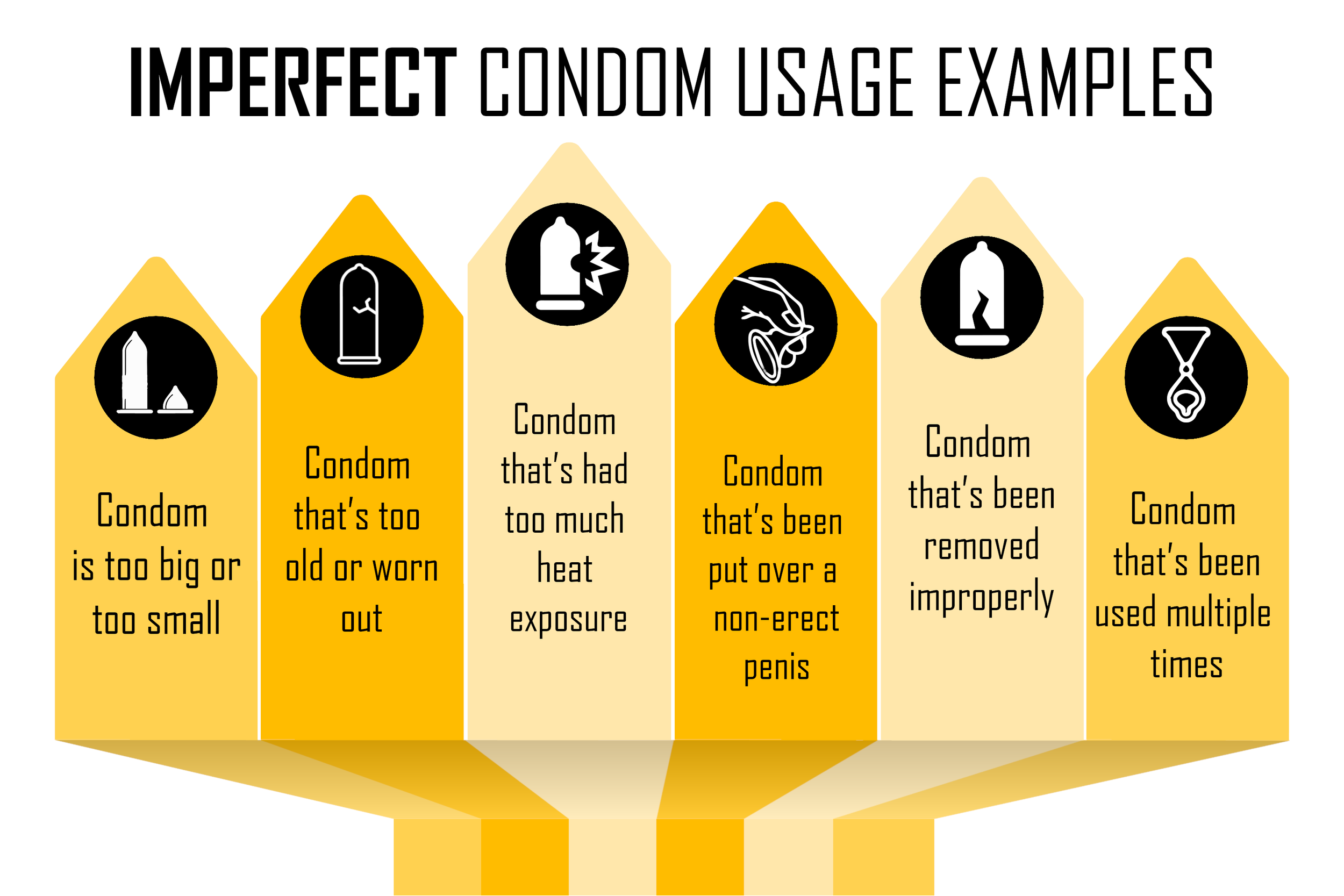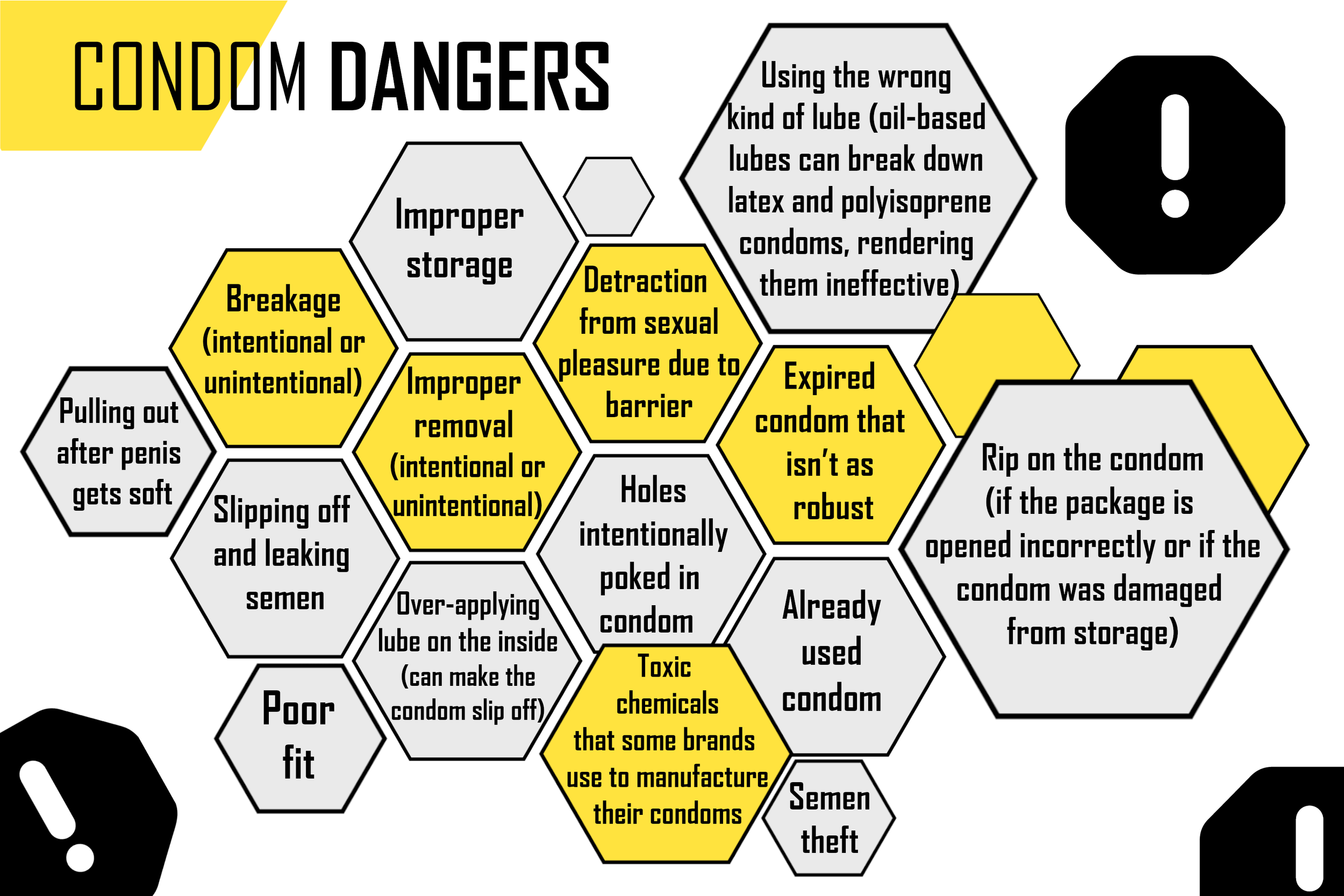
Condoms
A Wearable Barrier to Pregnancy and STIs
What Are Condoms?
Read More
Condoms are thin transparent pouches that fit over an erect penis and provide a protective physical barrier. The pouch blocks ejaculations from entering another person’s reproductive tract in order to prevent the onset of a pregnancy. Condoms also reduce the risk of transmission of STIs (sexually transmitted infections).
How Effective Are Condoms?
Read More
When used perfectly, condoms have a 98% effectiveness rate at preventing a pregnancy. When used in a typical way (accounting for human error and inconsistency), they are 82% effective (18 out of 100 couples who rely on the condom for their primary mode of birth control in the first year will become pregnant).
What Are External Condoms Made From?
Read More
Most condoms are made from a type of natural rubber called latex, but non-latex condoms, such as polyurethane and polyisoprene, are very popular options too. Latex is generally the most affordable and works well for most people, but some have a latex allergy or sensitivity. Other condoms are made from polyurethane, a plastic, and polyisoprene, a synthetic rubber similar to the feel of latex. These non-latex options don’t contain the natural proteins that are harmful to some individuals.
Latex-free options
Polyurethane condoms:
These are much thinner than latex condoms and offer a more natural feel to sex. They have less odor (usually none), provide more visibility of the penis, and are better for transmitting body heat and allowing the user to feel more of their partner—all of which can make these condoms less noticeable and disruptive during intercourse. Decreased elasticity is one drawback, as they don’t stretch as well as other condoms. This can lead to more instances of the contraception slipping off and tearing.
Polyisoprene condoms:
These have a similar sensation to their latex counterparts but with a less rubbery feel. They are also more resilient, soft, stretchy, and do a better job at transmitting heat and allowing the partners to really feel each other as naturally as possible. These make an excellent option for individuals with sensitive skin.
Natural skin condoms (not recommended):
“Natural skin” condoms (often referred to as lambskin) are made of the cecum, a membrane taken from the intestines of dead sheep. These condoms only offer pregnancy prevention because the condom isn’t sealed enough to prevent the transmission of STIs. Lambskin condoms won’t be recommended by SHK because of their inherent barbarity and there are clearly better options that don’t involve animal exploitation.
Getting Condoms
Where Can I Obtain Condoms?
Latex condoms are the most affordable and readily available, but all types of condoms can be found in stores and online. The most convenient sources include grocery stores, convenience stores, health centers, doctor’s offices, family planning clinics, and sexual health clinics.
Obtain Condoms with Confidence.
There’s no need to be timid or embarrassed when obtaining condoms. Most people have sex, it’s natural, and the more responsibly you have sex the more confident you should feel. Buying condoms is one of many ordinary aspects of life.
Use the Correct Size.
Size does matter when it comes to fitting. Make sure to use condoms that aren’t too big or too small for what you’re carrying. You can measure the length and girth of your erect penis and get condoms that are more likely to be the right fit. The standard condoms will fit most penises fine, but you’re more likely to have an effective condom if you use one that’s set up for your penis size.
Measure your erect penis length (base to tip) and girth (measure around the thickest part of the shaft). Condoms that fit well should feel comfy around the head and shaft but snug over the base of the shaft, with no slipping off or discomfort. Condoms that are poor-fitting and too big or too small can increase mishaps and intentionally risky behavior, such as removing a condom before sex is over due to the condom being distracting and making the sex unpleasant. Improperly fitted condoms can lead to slip-offs and breakages, as well as painful feelings as the penis can be too restricted if the condom is too small.
Buy, Store, and Wear Properly
Descriptive Marketing Terms That Help You Find the Right Condom
Smaller-sized penises: look for condoms labeled snug, slim, and close fit
Average-sized penises: these typically don’t carry any size-related terms
Larger-sized penises: look for condoms labeled large, XL, XXL, max, mega, or magnum
Proper Storage
Store condoms in cool and dry areas away from prolonged exposure to direct sunlight. Don’t keep condoms in pockets, wallets, or any hot areas for an extended period as they are vulnerable to deterioration.
Lube Up Wisely
Read More
A Lubricant is a liquid or gel that can be used during sex to enhance and sustain the action and pleasure for both partners. Most condoms already come lubricated. Lube can decrease or eliminate dryness, friction, skin irritation, and tears, as well as condom tears and breaks. Lube can be added to the outside of a condom (whether it’s already lubed or not) or onto the tip of the penis. Lube can also be directly applied to the partner’s vulva or anus.
Pros and Cons
Recommended Brands:
Sources and Additional Resources
The Difference Between Latex and Non-Latex Condoms. (n.d.). Royal. Retrieved June 27, 2022, from https://www.alwaysberoyal.com/blogs/pillowtalk/latex-non-latex-condoms
Latex Allergy | AAFA.org. (2018). Aafa.org. https://www.aafa.org/latex-allergy/
Mayo Clinic. (2019). Latex allergy - Symptoms and causes. Mayo Clinic. https://www.mayoclinic.org/diseases-conditions/latex-allergy/symptoms-causes/syc-20374287
Why the Buzz Over Lifestyles SKYN Non-Latex Condoms? (n.d.). Verywell Health. https://www.verywellhealth.com/skyn-non-latex-condoms-906782
Roll, R. N. (n.d.). Non-Latex Condoms, Are They Better Than Latex? Rip N Roll. Retrieved June 27, 2022, from https://www.ripnroll.com/blogs/sexual-education/non-latex-condoms-vs-latex
Polyisoprene Condoms | Condoms.uk. (n.d.). Condoms.uk. https://condoms.uk/collections/polyisoprene-condoms
Types of condoms | Go Ask Alice! (n.d.). Goaskalice.columbia.edu. https://goaskalice.columbia.edu/answered-questions/types-condoms
How to Have Safer Sex with Polyurethane Condoms. (2020, April 27). Healthline. https://www.healthline.com/health/healthy-sex/polyurethane-condoms
If You’re Allergic to Latex, Try Polyurethane Condoms. (2021, March 30). Greatist. https://greatist.com/health/polyurethane-condoms#Takeaway
Condom Knowledge-All You Need to Know. (n.d.). ZIOXX. Retrieved June 27, 2022, from https://www.zioxx.com/blogs/news/condom-knowledge
How to Have Safer Sex with Polyurethane Condoms. (2020, April 27). Healthline. https://www.healthline.com/health/healthy-sex/polyurethane-condoms#takeaway
How to Use a Internal Condom | CDC. (2022, February 10). Www.cdc.gov. https://www.cdc.gov/condomeffectiveness/internal-condom-use.html?CDC_AA_refVal=https%3A%2F%2Fwww.cdc.gov%2Fcondomeffectiveness%2FFemale-condom-use.html
Office on women's health. (2018, March 16). Menstrual cycle tool. Womenshealth.gov. https://www.womenshealth.gov/menstrual-cycle/your-menstrual-cycle
Bager, J. (2022, November 11). Condom Industry Statistics [market size report]. Bedbible.com. https://bedbible.com/condom-industry-statistics
How do you use lube with condoms? (n.d.). Www.plannedparenthood.org. Retrieved June 27, 2022, from https://www.plannedparenthood.org/learn/teens/ask-experts/how-do-you-use-lube-with-condoms
“Stealthing”: Why Non-consensual Condom Removal Is A Big Deal. (n.d.). SKYN® US. Retrieved June 27, 2022, from https://skynfeel.com/blogs/sexuality/stealthing-why-non-consensual-condom-removal-is-a-big-deal
NHS Choices. (2021, March 17). Your contraception guide. NHS. https://www.nhs.uk/conditions/contraception/


















